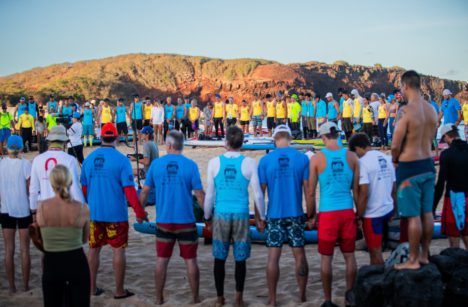M2O Brings Racers, Competition, Controversy
By Jack Kiyonaga, Editor

Photo courtesy of Shannon Delaney.
More than 200 athletes representing over 20 countries pushed off the sandy shores of Kepuhi Beach last Sunday to compete in the Molokai 2 Oahu (M2O) paddle board world championships. Competing on standup paddles, prone boards, hydrofoils and more, the athletes were joined by escort boats on their 32-mile journey across the notorious Ka’iwi Channel. As the last of the boats disappeared into the blue horizon, many Molokai residents were left with questions, concerns, and, in some cases, trash to contend with.
The return of the 24th annual M2O after a three-year pandemic break caught many Molokai residents by surprise.
Lori-Lei Rawlins-Crivello helps facilitate the Molokai Hoe and Na Wahine O Ke Kai canoe races later in the fall with her husband Kawika Crivello. While not affiliated with the M2O, Rawlins-Crivello has worked for years to help bridge the gap between the paddling and Molokai community.
Rawlins-Crivello explained that she wasn’t even aware the M2O was happening until a week before the event. Immediately following the race on Sunday, residents reached out to Rawlins-Crivello with concerns over the behavior of race participants. Rawlins-Crivello explained that incidents included escort boats speeding close to shore and near divers at Pohakumauliuli, also known as Make Horse, trash from campers left at Hale O Lono and Papohaku Beach Park, and two escort boats seen diving off Kalaupapa pier.
“Of course, the biggest issue is our resources because it is our lifestyle,” said Rawlins-Crivello.
Incidents like these in the past have led to conflict between residents and visiting paddlers, she explained.
“It got to the point that paddlers were afraid to come and race organizers were concerned,” she added.
In response, Rawlins-Crivello started the Kaulia festival, which precedes the Molokai Hoe and Na Wahine o Ke Kai races and allows the Molokai community to interact with and educate visiting athletes. She now worries though that negative feelings about the races could affect future events.
Shannon Delaney, executive director for the M2O, confirmed that race organizers were made aware of several incidents after-the-fact.
“The damage was done,” said Delaney. “The experience that we have in the channel and on the island is pretty incredible. So obviously we were super sad to hear some of the major concerns. Hopefully we can get in front of it all and open up even more dialogue.”
Delaney explained that while numbers for the race have not grown since it was last held in 2019, the visibility of holding the start of the event at Kepuhi Beach makes it different from other Molokai races.
Every racer is required to have an escort boat. With 162 entries, plus eight safety launches and two camera boats, the event brought close to 200 boats to Molokai’s waters.
According to Delaney, usually the race hires several local boats to make sure escorts are following race behavior guidelines. The M2O has a Molokai protocol which includes rules prohibiting fishing or diving within 500 yards of shore. Several boats who have violated these rules have been “black-balled” in the past, explained Delaney.
This year, according to Delaney, there were no Molokai boats patrolling. Delaney was unsure as to why.
Delaney highlighted a couple ideas that race organizers are considering moving forwards, such as having safety boats launch from Oahu and employing GPS to cut down on the number of escort boats needed.
Mike Takahashi is the founder of the M2O and the race director.
“Our event could have benefitted from more community reach out, especially on the heels of the pandemic,” said Takahashi.
Takahashi likewise addressed the trash left on Molokai’s beaches.
“Moving forward, we will provide temporary bathroom facilities, security and clean up at the harbor,” he said. “Then also clean up and patrol at Kepuhi Beach, Make Horse, and Papohaku Beach Park.”
The M2O partnered with Youth in Motion to help run the Molokai Holokai Ho’olaule’a, held last month. Clare Albino, founder of Youth in Motion, explained that the M2O helps fund events like the Molokai Holokai and that many of the racers overlap between events.
“We are working on monthly meetings and will address more inclusion with the event,” said Albino.
While challenges remain in bringing together the visiting athletes and the Molokai community, Rawlins-Crivello remains optimistic that with firmer consequences for illicit actions and better community engagement, the races can become a positive experience for everyone.
“We see that there is a way to have a balance, and if we can find solutions to these problems, I think there is room for us to have these races,” said Rawlins-Crivello. However, she added addressing race organizers, “you guys need to solve some of those issues being brought up by our community or they will shut it down.”
For the race itself, Molokai was represented by Lihau Maioho, who competed in the wing foil division. Molokai’s Alex Mawae, winner of his age group in 2019, was unable to race this year.
More information about the M2O and race results can be viewed at molokai2oahu.com.











Don't have a Molokai Dispatch ID?
Sign up is easy. Sign up now
You must login to post a comment.
Lost Password